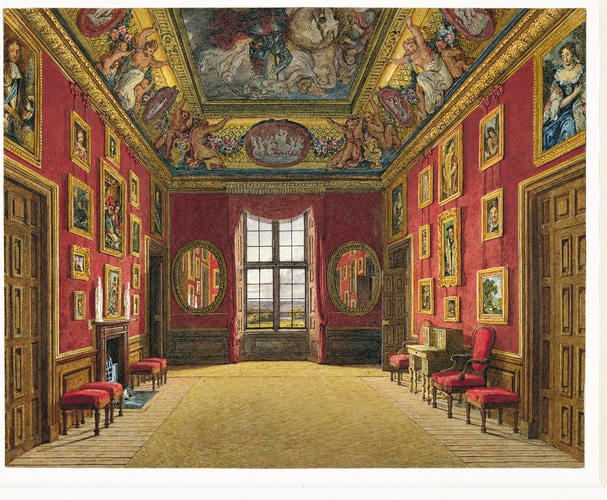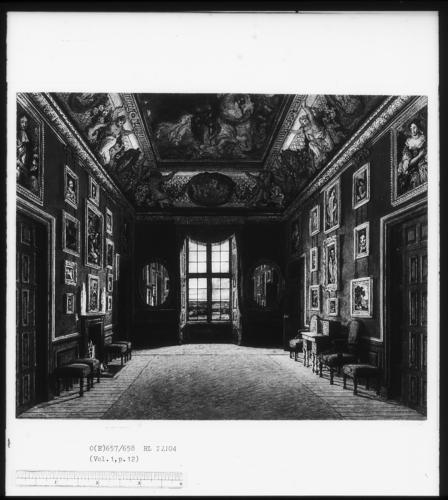Windsor Castle: The King's Closet, 1816 c. 1816
Pencil and watercolour with touches of bodycolour | 20.0 x 25.1 cm (sheet of paper) | RCIN 922104
-
A watercolour depicting The King's Closet, a small room with red cloth walls and small pictures of royal portraits and Old Masters. Prepared for one of the plates in William Henry Pyne's History of the Royal Residences (1816-1819). Engraved by W. I.[J?] Bennett, the print published 1.10.1816.
The King's Closet lies at the western end of the King's State Apartment, rebuilt by Hugh May for Charles II in 1675-8 as part of the overall modernisation of Windsor. This great project, which was completed in 1684 within a few months of Charles II's death, provided two back-to-back suites of rooms - eight for the King, seven for the Queen - mainly within the so-called Star Building on the north side of the Upper Ward of the castle. The Baroque planning and decoration of these rooms, which was entirely new in England at this date, reflected the pattern for State Apartments established at the court of the King's cousin, Louis XIV of France. Antonio Verrio was employed to paint the ceilings with an elaborate iconographic programme relating to Charles II and Catherine of Braganza, and rich carvings were supplied by Grinling Gibbons and Henry Phillips. The ceiling of the King's Closet was originally painted with scenes of Jupiter and Leda. When George III embarked on a programme of modernisation of the State Apartments in the early nineteenth century under the direction of James Wyatt, the Closet was enlarged by the addition of an ante-room to the south and a new ceiling depicting St George and the Dragon was painted by Matthew Cotes Wyatt in 1807. The pictures, symmetrically hung on red cloth-covered walls, included Vermeer's Lady at the virginal, identified by Pyne under its old attribution of Frans van Mieris, together with a mixture of family portraits and Old Masters, some brought by George III from Buckingham House. The furniture was similarly mixed and included a seaweed marquetry desk that had belonged to William III and a pair of oval mirrors designed by John Yenn and supplied in 1794-5. The room was altered again by Jeffry Wyatville for William IV in the early 1830s when M.C. Wyatt's ceiling was replaced and a chimneypiece from Buckingham House was installed.
Every painting visible here can be identified from the 1816 inventory of Windsor Castle. The four overdoors are, at this end, Wissing’s William III (left, 404445) and Mary (right, 404449), at the far end, Lely’s James II (left, 407810) and Anne Hyde (right, 405641). The centre of the left wall has, at the top, Pencz’s Erasmus (406202), perched over Reymerswaele’s Misers (405707), below this (immediately over the mantle) is Vermeer’s Music Lesson (405346). These three are framed by four pairs of paintings: across the top, Luini, St Catherine (left, 406439) and Reni’s St Sebastian (right, 405562); second row has two paintings by the circle of Poussin, an Agony in the Garden (left, 406786) and Angel appearing to the Shepherds (right, 402780); below this comes Albani’s Nymph and Satyr (left, 403005) and Dou’s Woman watering a Flower (right, 404621); two small works by the studio of Carlo Dolci hang across the bottom - Christ (left, 400625) and Virgin (right, 4000637).
The right wall has the same arrangement: the central stack of paintings has an anonymous Edward VI at the top (404441), over Holbein’s Duke of Norfolk (404439), with Rubens’s Christ in the House of Simon (404342) immediately over the mantle. These are framed by three pairs, at the top Correggio’s St Catherine (left, 405768) and Reni’s St John (right, 406111), next down come two heads by Denner, Age (left, 405619) and Youth (right, 405618); across the bottom a pairing of Steenwyck’s Liberation of St Peter (left, 403041) with Swanevelt's Landscape (right, 403529).
This painting is closely associated with The History of the Royal Residences by the watercolour artist W.H. Pyne (1769-1843), published in three volumes in 1819. The hundred plates which illustrated Pyne's account appeared in batches of four, monthly or bi-monthly, from February 1816. The associated watercolours at Windsor, some of which are painted over first states of the associated engravings, were formerly housed in a binding similar to that used for some of George IV's books. Although the arrival (at Carlton House) of instalments of the published work is noted, no record of the delivery of the watercolours appears to have survived. Pyne's great publishing project was embarked on as an independent commercial venture. It received royal support, but no royal funding and Pyne - like Whittaker - was driven to bankruptcy by the costs involved in his magnificent venture.
Catalogue entry from Royal Treasures, A Golden Jubilee Celebration (London, 2002)Provenance
Probably acquired by George IV
-
Creator(s)
Acquirer(s)
-
Medium and techniques
Pencil and watercolour with touches of bodycolour
Measurements
20.0 x 25.1 cm (sheet of paper)
Other number(s)
RL 22104Alternative title(s)
The King's Closet, Windsor Castle
The King's Closet, also called the Queen's Closet, Windsor Castle.











